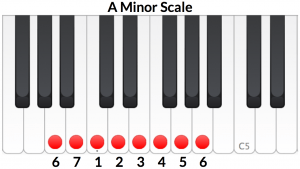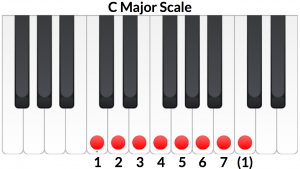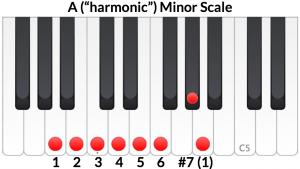Two ways to understand minor songs

In other posts and videos, I’ve talked about how identifying a song’s key and scale helps you build powerful connections between your chords and what you play melodically. All the examples have been based in major keys, but how can you understand minor songs?
Two different systems for minor
To fully understand minor songs, you need to process notes and chords two different ways, almost at the same time.
- The first way is to see the notes as connected to a relative major scale.
- The second way is to see the minor scale as its own entity, needing adjustments to fully function as minor.
 Understand minor songs as relative major keys
Understand minor songs as relative major keys
In the first sense, an A minor scale is nothing but a C major scale started on a different note. They both have the same key signature – all naturals. Because they have the same key signature, they are relatives.
This plays out in two important ways. If we have a chord progression of Am – F – C – G – Am, it sounds at home as A minor. But we can also understand the chords as the 6, 4, 1, and 5 chords of C major and utilize  those connections.
those connections.
The other way it plays out is that we can understand melody notes (in the video, I demonstrate the 1, 5, and 7 scale notes of C major) as functioning the same way in the relative minor.
Getting the full picture
Understanding the relative major gets us most of the way there, but minor songs often deviate a bit.
In the video, I discuss the importance of a leading tone – a half-step below the home note – in establishing the key. The minor scale, in its natural form, does not have that leading tone. To compensate, we often raise the 7th note of the minor scale to give it that pull into the home note.

The harmonic and melodic versions of the minor scale do just that. Taking that adjusted seventh note into account, we end up with some different chords. For example, a song in A minor might contain an E7 chord. In this case, it’s not helpful to view the E as an altered version of C major’s 3-chord. It’s fully functioning as the dominant 5-chord in A minor.
Therefore, the second way we must understand minor songs is as their own entity, with the numbers starting on the first note of the scale and chord numbers derived from that.
Analyze it!
To understand a minor song, first go through the steps to identify the relative major key. Be clear about the key signature and the scale of the key. From there, check to see if a different leading tone is setting up the relative minor as home.
These concepts take experience to fully grasp. But try them with a number of minor songs, and you will be on your way!

